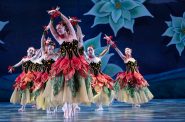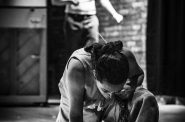Trey McIntyre, the real deal in dance
The staggering volume and density of invention in Trey McIntyre’s dances boggle the mind. You could easily spend 1,000 words describing any 10 seconds of the complex partnering his nine dancers executed with such panache Tuesday evening at Marcus Center Uihlein Hall.
McIntyre’s astonishing novelty would be enough, but it’s only the beginning of interest. He grasps the physics of the body and of bodies in combination completely; his dancers’ interactions have a vastly pleasing sort of Rube Goldberg logic. You see the set up — she’s in the air, that guy’s flat on the on the floor, the other guy’s crouched nearby — and wonder how will this mass/momentum/direction/reaction equation be solved. A roll, a dodge and a catch later, it all makes perfect sense.
Layer onto that an acute musicality that responds to or counters every nuance in music from Mendelssohn to the Partridge Family. And layer onto that an uncanny ability to harness prolific invention into coherent, spring-loaded phrases. You can take it all in, but your mind and eye must race to keep up. That race is exhilarating.
But wait, there’s more! McIntyre’s canny theatrical sense and warm heart make his dances more than physical/mental workouts (which would be enough for me).
Ma Maison sound world combines Mardi Gras, Day of the Dead and old-time New Orleans jazz and street Gospel. Jeanne Button’s costumes suggest a gaudy Halloween party thrown by minstrels — everyone wears white shoes and oversize white gloves, against a black background. Michael Curry’s skull masks — the dancers can add a sardonic rictus at will — give the piece a macabre cast.
McIntyre’s hurricane of steps throws ballet, New Orleans funeral strut, cakewalk and other assorted ragtime dances, jitterbug, voudon possession dances, vaudevillian soft shoe and who knows what else into a whirl. It’s outrageous and dizzying, and yet, you can comprehend it. You can feel the ebb and flow of energy as phrases gather and dissipate.
One McIntyre trick helps you absorb his dances. He likes to interrupt strings of rapid, explosive movement, in place or traveling, with sudden stillness. Often, a partner will gently but firmly arrest the motion of a gyrating or flying dancer. The two wait for a long moment, during which we can consider what we’ve just seen and compare it with what we expected — the landing after a jump, say. Such moments give us time to think about the dance, and brother, McIntrye’s dances call for some thinking.
This arrested-motion trick occurred in all three dances on this program and started to look like a characteristic of McIntyre’s work. Other than that, you would have thought three different people choreographed these vastly different numbers.
Ten Pin Episodes, to short Chopin piano works and intermittent ominous rumbling, extends the periods of stillness amid athletic outbursts. The three women and three men have plenty of speedy athletic work to do, but the vibe is zen-like. The object of their meditation: bowling pins, and how their curves fit the human body, how they roll asymmetrically when toppled, and how like the human body they are in their tendency to topple.
Wild Sweet Love, to a crazy-quilt score from the Zombies to Mendelssohn to Roberta Flack, glows with sunlit love. Four couples in white cavort in glorious, playful athleticism that reads as the very picture of healthy love. The magnificent Ilana Goldman is the odd woman out.
Goldman is nearly six feet tall and impossibly quick and controlled with her impossibly long limbs. She appeared to tear herself apart as Flack sang the title song. McIntyre sent her arms and legs and knees and hips and shoulders into a violent contrary motion that was at once thrilling and heartbreaking. Goldman did not have to act her character’s loneliness; McIntyre built it into her magnificent dancing body.
All McIntyre’s dancers are magnificent in their speed, fearlessness, command, musicality and presence. Here’s hoping we see Goldman, Chanel DaSilva, Lauren Edson, Dylan G-Bowley, Jason Hartley, Brett Perry, Annali Rose, John Michael Schert and Asley Werhun again soon. The Trey McIntyre Project is a great company led by a great choreographer.
McIntyre choreographed the young dancers of Milwaukee Ballet II into a small collective role in Wild Sweet Love. He didn’t have to go to the trouble, but he did. It made sense in the dance and it was a nice gesture. Click here to read an interview with McIntyre and for links to more about him.
Dance
-
Milwaukee Ballet Brings Back Orchestra
 Jul 14th, 2025 by Bruce Murphy
Jul 14th, 2025 by Bruce Murphy
-
New Riverwest Company, Production Impresses
 Feb 10th, 2020 by Brendan Fox
Feb 10th, 2020 by Brendan Fox
-
Milwaukee Ballet Show Remakes History
 Feb 10th, 2020 by Catherine Jozwik
Feb 10th, 2020 by Catherine Jozwik





















